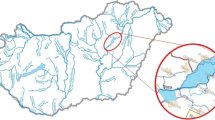Abstract
Bioindicators are useful for environmental monitoring in ecosystems with pollution loads. We compared concentrations of selected 10 metals in 42 samples of House Sparrow in a polluted by thermal power plant and reference sites. We found mean tissue concentrations of some metals to be significantly higher in sparrows from the polluted area when compared to tissues from the reference site. In liver mean concentrations of Cu (35.85 ± 17.22 mg kg−1) and Zn (101.76 ± 26.38 mg kg−1) were significantly higher and concentration of Ni (0.43 ± 0.49 mg kg−1) were significantly lower in sparrows from the polluted area (p < 0.05). The concentration of Cu was significantly higher in muscle and liver at the polluted site. Gender did not seem to influence residue levels, of the elements studied, among sparrows with the exception of kidney cobalt concentrations; which were higher in female sparrows than in males (p < 0.05, t = −2.409).
Similar content being viewed by others
References
Alleva E, Francia N, Pandolfi M, Marinis AMD, Chiarotti F, Santucci D (2006) Organochlorine and heavy-metal contaminants in wild mammals and birds of Urbino-Pesaro Province, Italy: an analytic overview for potential bioindicators. Arch Environ Contam Toxicol 51:123–134
Anderson TR (2006) Biology of the ubiquitous House Sparrow: from genes to populations. Oxford University Press, New York
Baba A, Kaya A, Birsoy YK (2003) The effect of Yatagan Thermal Power Plant (Mugla, Turkey) on the quality of surface and groundwaters. Water Air Soil Pollut 149:93–111
Bianchi N, Ancora S, Di Fazio N, Leonzio C (2008) Cadmium, lead, and mercury levels in feathers of small passerine birds: noninvasive sampling strategy. Environ Toxicol Chem 27:2064–2070
Burger J, Bowman R, Woolfenden GE, Gochfeld M (2004) Metal and metalloid concentrations in the eggs of threatened Florida scrub-jays in suburban habitat from south-central Florida. Sci Total Environ 328:185–193
Chao P, Guangmei Z, Zhengwang Z, Chengyi Z (2003) Metal contamination in tree sparrows in different locations of Beijing. Bull Environ Contam Toxicol 71:142–147
Deng HL, Zhang ZW, Chang CY, Wang Y (2007) Trace metal concentration in Great Tit (Parus major) and Greenfinch (Carduelis sinica) at the Western Mountains of Beijing, China. Environ Pollut 148:620–626
Eens M, Pinxten R, Verheyen RF, Blust R, Bervoets L (1999) Great and blue tits as indicators of heavy metal contamination in terrestrial ecosystems. Ecotoxicol Environ Safety 44:81–85
Ek KH, Morrison GM, Lindberg P, Rauch S (2004) Comparative tissue distribution of metals in birds in Sweden using ICP-MS and laser ablation ICP-MS. Arch Environ Contam Toxicol 47:259–269
Feng XB, Qiu GL (2008) Mercury pollution in Guizhou, Southwestern China—an overview. Sci Total Environ 400:227–237
Lebedeva NV (1997) Accumulation of heavy metals by birds in the southwest of Russia. Russian J Ecol 28:41–46
Nam DH, Anan Y, Ikemoto T, Okabe Y, Kim EY, Subramanian A, Saeki K, Tanabe S (2005) Specific accumulation of 20 trace elements in great cormorants (Phalacrocorax carbo) from Japan. Environ Pollut 134:503–514
Swaileh KM, Sansur R (2006) Monitoring urban heavy metal pollution using the House Sparrow (Passer domesticus). J Environ Monit 8:209–213
Tovar-Sanchez A, Huerta-Diaz MA, Negro JJ, Bravo MA, Sanudo-Wilhelmy SA (2006) Metal contamination in interstitial waters of Donana Park. J Environ Manag 78(3):286–293
Vahter M, Akesson A, Liden C, Ceccatelli S, Berglund M (2007) Gender differences in the disposition and toxicity of metals. Environ Res 104:85–95
Acknowledgments
The research was supported by Mehmet Akif Ersoy University (BAP 0093-NAP-10). We are grateful to H. Kuleaşan and H. Tunçmen who helped with the analyses of the bird samples. We thank Işıl and Deniz Albayrak for their efforts in the field work.
Author information
Authors and Affiliations
Corresponding author
Rights and permissions
About this article
Cite this article
Albayrak, T., Mor, F. Comparative Tissue Distribution of Heavy Metals in House Sparrow (Passer domesticus, Aves) in Polluted and Reference Sites in Turkey. Bull Environ Contam Toxicol 87, 457–462 (2011). https://doi.org/10.1007/s00128-011-0364-2
Received:
Accepted:
Published:
Issue Date:
DOI: https://doi.org/10.1007/s00128-011-0364-2




